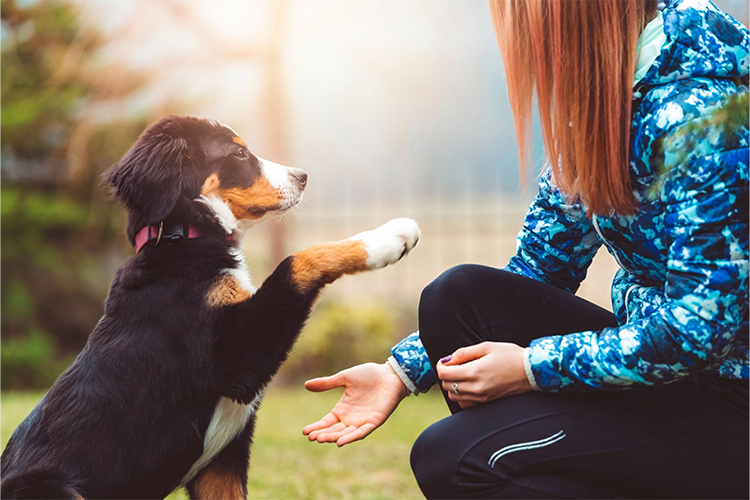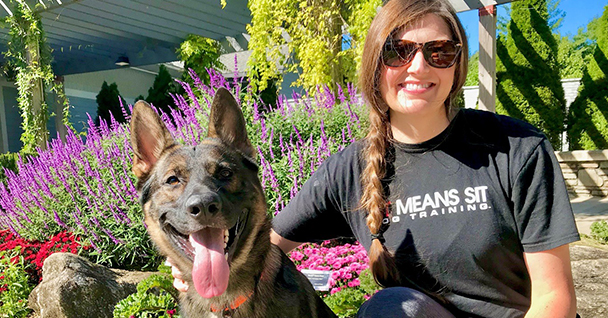Common Behavioral Issues and Their Solutions in Dog Training
Common Behavioral Issues and Their Solutions in Dog Training
Blog Article
Essential Tips for Successful Dog Training: A Guide for Pet Owners
Reliable pet training is a complex process that requires a critical method tailored to both the pet dog's temperament and the owner's objectives. Comprehending exactly how to browse these obstacles can dramatically improve the training experience, eventually transforming the relationship between owner and pet.
Recognizing Canine Habits
Understanding pet habits is important for efficient training and cultivating an unified relationship in between dogs and their proprietors. dog training. Dogs interact mostly via body language, articulations, and actions, making it important for proprietors to translate these signals accurately.

Socialization plays a considerable role in dog habits; direct exposure to different environments, people, and other animals can considerably influence a dog's temperament. In addition, variables such as type qualities and individual temperament must lead training methods, as some breeds might have details behavioral characteristics that demand tailored approaches. By comprehending these aspects, proprietors can develop a helpful environment that motivates favorable actions, resulting in successful training outcomes and a much deeper bond with their pet dogs.
Establishing Consistent Commands
Efficient communication with your pet dog begins with developing consistent commands. This foundational component of training is crucial for cultivating understanding between you and your family pet. Uniformity in the commands you utilize makes sure that your canine can reliably link certain words or expressions with the desired actions.
When choosing commands, select clear, unique words that are very easy to claim and set apart from each other. Prevent using similar-sounding commands that might perplex your pet. Using "rest" and "stay" is proper, but "rest" and "struck" could lead to misunderstandings.
In addition, preserve the same tone and volume for each command. Pets are sensitive to vocal signs, so differing your tone can develop complication.
It is equally crucial to guarantee that all household members are on the very same page relating to the commands made use of. A united front in command use will stop mixed signals and strengthen the learning procedure.
Favorable Reinforcement Methods
The power of positive reinforcement in canine training exists in its capacity to motivate preferred habits through incentives and praise. This method is based in the concept that actions adhered to by favorable end results are most likely to be duplicated. By including positive support right into your training regimen, you can efficiently shape your dog's behavior in a useful way.
To implement positive support, it's vital to identify what inspires your pet, whether it be treats, playthings, or spoken praise. When your canine executes a preferred activity, such as resting on command, quickly reward them with a reward or affection. This association in between the command and the positive outcome enhances their understanding.
It's critical to timing the rewards appropriately; delivering the reinforcement within secs of the preferred behavior aids your canine make the link (dog training). Additionally, consistency is vital-- make sure that all household participants make use of the same commands and reward systems to stay clear of confusion

Progressively, you can decrease the regularity of treats as your canine discovers the habits, transitioning to praise or intermittent rewards. This approach not just cultivates a strong bond in between you and your dog yet additionally promotes a favorable knowing atmosphere, making training a delightful experience for both.
Socialization and Communication
Constantly revealing your dog to a variety of environments, people, click to read more and other animals is important for their social advancement. Socialization must begin early, ideally during the crucial window of 3 to 14 weeks, when young puppies are most responsive to new experiences. Older canines can likewise benefit from ongoing socializing efforts.
Present your pet to various settings, such as parks, pet-friendly shops, and urban areas. This direct exposure aids them adapt to various stimulations, decreasing stress and anxiety and find out this here worry feedbacks. Encourage favorable interactions with various other canines and individuals, guaranteeing that these encounters are controlled and secure to promote self-confidence.
Use organized playdates with courteous pet dogs, as this can enhance your pet's social abilities and show them appropriate habits. Obedience courses and training sessions additionally supply excellent possibilities for socializing, permitting your canine to communicate with others in a monitored environment.
Display your dog's body language during communications, as this will assist you gauge their comfort degree. Gradually increase direct exposure to more challenging scenarios while making sure that each experience declares. A well-socialized pet is more probable to show well balanced behavior, making them a delight to have in any kind of setting.
Addressing Common Training Obstacles
Every pet proprietor will experience training obstacles at some point, despite their dog's age or socializing level. Identifying usual issues such as stubbornness, distractions, and fearfulness can assist in you could try this out developing effective approaches for renovation.

Progressively present distractions as the pet dog comes to be more efficient in commands. Short, constant training sessions are additionally efficient in preserving interest.
Terror can hinder a pet dog's learning procedure. Gradual desensitization to the source of anxiety, coupled with positive support, can help alleviate anxiousness. Persistence is crucial; never force a dog right into a scenario that causes distress, as this may worsen the issue.
Eventually, understanding and attending to these typical challenges with an organized approach will certainly foster a much more efficient training experience, reinforcing the bond in between canine and owner while advertising reliable learning.
Conclusion
In summary, successful canine training depends on an extensive understanding of canine actions, the establishment of regular commands, and the application of favorable support methods. Socializing plays a critical duty in establishing well-adjusted family pets, while attending to usual training obstacles needs persistence and adaptability. By applying these crucial strategies, pet owners can foster a strong bond with their pet dogs and promote desirable actions, inevitably resulting in a harmonious connection in between human beings and their canine buddies.
Comprehending dog actions is important for reliable training and fostering a harmonious relationship between pooches and their owners.Socialization plays a significant duty in pet dog actions; exposure to numerous environments, individuals, and other pets can substantially affect a canine's personality.The power of positive support in pet training exists in its capacity to urge desired actions via benefits and praise. By incorporating favorable reinforcement into your training program, you can successfully shape your pet dog's habits in a positive fashion.
In recap, effective canine training depends on a thorough understanding of canine habits, the facility of regular commands, and the application of positive reinforcement methods.
Report this page